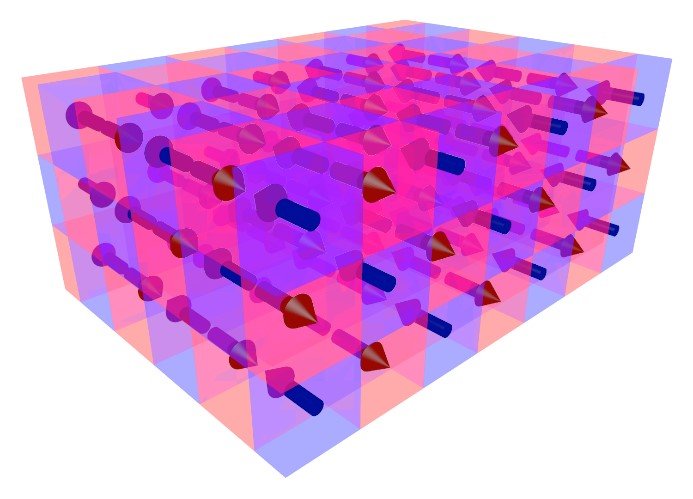Storing information in antiferromagnetic materials

The microscopic moments in antiferromagnetic materials have alternated orientation, in contrast to the ones of ferromagnets.
ill./©: Lorenzo Baldrati, JGU
Researchers at Mainz University were able to show that information can be stored in antiferromagnetic materials and to measure the efficiency of the writing operation
We all store more and more information, while the end devices are supposed to get smaller and smaller. However, due to continuous technological improvement, conventional electronics based on silicon is rapidly reaching its limits – for example limits of physical nature such as the bit size or the number of electrons required to store information.
Spintronics, and antiferromagnetic materials in particular, offers an alternative. It is not only electrons that are used to store information, but also their spin containing magnetic information. In this way, twice as much information can be stored in the same room. So far, however, it has been controversial whether it is even possible to store information electrically in antiferromagnetic materials.
Physicists unveil the potential of antiferromagnetic materials
Researchers at Johannes Gutenberg University Mainz (JGU), in collaboration with Tohoku University in Sendai in Japan, have now been able to prove that it works: “We were not only able to show that information storage in antiferromagnetic materials is fundamentally possible, but also to measure how efficiently information can be written electrically in insulating antiferromagnetic materials,” said Dr. Lorenzo Baldrati, Marie Sklowdoska-Curie Fellow in Professor Mathias Kläui’s group at JGU. For their measurements, the researchers used the antiferromagnetic insulator Cobalt oxide CoO – a model material that paves the way for applications.
The result: Currents are much more efficient than magnetic fields to manipulate antiferromagnetic materials. This discovery opens the way toward applications ranging from smart cards that cannot be erased by external magnetic fields to ultrafast computers – thanks to the superior properties of antiferromagnets over ferromagnets. The research paper has recently been published in Physical Review Letters. In further steps, the researchers at JGU want to investigate how quickly information can be saved and how “small” the memory can be written to.
Active German-Japanese exchange
“Our longstanding collaboration with the leading university in the field of spintronics, Tohoku University, has generated another exciting piece of work”, emphasized Professor Mathias Kläui. “With the support of the German Exchange Service, the Graduate School of Excellence Materials Science in Mainz, and the German Research Foundation, we initiated a lively exchange between Mainz and Sendai, working with theory groups at the forefront of this topic. We have opportunities for first joint degrees between our universities, which is noticed by students. This is a next step in the formation of an international team of excellence in the burgeoning field of antiferromagnetic spintronics.”
Image:
http://download.uni-mainz.de/presse/08_physik_antiferromagneten_informationsspei…
The microscopic moments in antiferromagnetic materials have alternated orientation, in contrast to the ones of ferromagnets.
ill./©: Lorenzo Baldrati, JGU
Related links:
https://spintronicsartes.wordpress.com/ – Antiferromagnetic Spin Transport and Switching (ARTES) project of Marie Skłodowska-Curie Fellow Dr. Lorenzo Baldrati ;
https://www.klaeui-lab.physik.uni-mainz.de/ – Kläui Lab at the JGU Institute of Physics ;
https://www.blogs.uni-mainz.de/fb08-iph-eng/ – JGU Institute of Physics ;
http://www.mainz.uni-mainz.de/ – Graduate School of Excellence Materials Science in Mainz (MAINZ) ;
https://www.uni-kl.de/trr173/ – DFG Collaborative Research Center/Transregio 173: Spin+X – Spin in its collective environment
Read more:
https://www.uni-mainz.de/presse/aktuell/10211_ENG_HTML.php – press release “Physicists make one step toward using insulating antiferromagnetic materials in future components” (25 Oct. 2019) ;
https://www.uni-mainz.de/presse/aktuell/6140_ENG_HTML.php – press release “New devices based on rust could reduce excess heat in computers” (17 Sept. 2018) ;
http://www.uni-mainz.de/presse/aktuell/4356_ENG_HTML.php – press release “Construction set of magnon logic extended: Magon spin currents can be controlled via spin valve structure” (14 March 2018) ;
http://www.uni-mainz.de/presse/aktuell/3937_ENG_HTML.php – press release “Antiferromagnets prove their potential for spin-based information technology” (29 Jan. 2018)
Wissenschaftliche Ansprechpartner:
Dr. Lorenzo Baldrati
Institute of Physics
Johannes Gutenberg University Mainz
55099 Mainz, GERMANY
phone: +49 6131 39-27231
fax: +49 6131 39-24076
e-mail: lbaldrat@uni-mainz.de
https://www.klaeui-lab.physik.uni-mainz.de/team/
https://spintronicsartes.wordpress.com/
Originalpublikation:
L. Baldrati et al., Efficient Spin Torques in Antiferromagnetic CoO/Pt Quantified by Comparing Field- and Current-Induced Switching, Physical Review Letters 125:7, 077201, 10. August 2020,
DOI: 10.1103/PhysRevLett.125.077201
https://journals.aps.org/prl/abstract/10.1103/PhysRevLett.125.077201
Media Contact
All latest news from the category: Information Technology
Here you can find a summary of innovations in the fields of information and data processing and up-to-date developments on IT equipment and hardware.
This area covers topics such as IT services, IT architectures, IT management and telecommunications.
Newest articles

Bringing bio-inspired robots to life
Nebraska researcher Eric Markvicka gets NSF CAREER Award to pursue manufacture of novel materials for soft robotics and stretchable electronics. Engineers are increasingly eager to develop robots that mimic the…

Bella moths use poison to attract mates
Scientists are closer to finding out how. Pyrrolizidine alkaloids are as bitter and toxic as they are hard to pronounce. They’re produced by several different types of plants and are…

AI tool creates ‘synthetic’ images of cells
…for enhanced microscopy analysis. Observing individual cells through microscopes can reveal a range of important cell biological phenomena that frequently play a role in human diseases, but the process of…





















